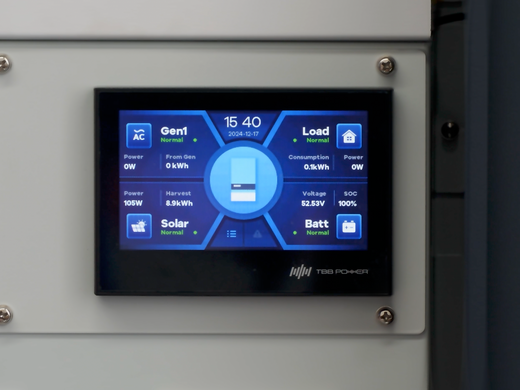The E4 TBB Monitoring Unit is a pivotal tool for monitoring and managing your off-grid Solar Nest system. This guide offers an in-depth walkthrough, covering essential features, settings, and operational tips to help you maximize the potential of your system.
Overview of Summary Panes
The monitoring interface provides various summary panes to keep track of system performance:

- Battery Pane (Bottom right): Displays the state of charge (SOC) and overall health of your battery, which is typically the most critical component to monitor.
- Load Pane (Top right): Shows the power being drawn from the system, whether by critical or non-critical loads.
- Generator Pane (Top left): Tracks the utility or AC input, such as from a generator, including how much power is coming in.
- Solar Pane (Bottom left): Monitors solar power generation, displaying real-time input and daily totals.
Each pane can be clicked to reveal detailed information, including graphical data that can also be accessed via the mobile monitoring app.
Key Features and Daily Monitoring Tips
Battery Monitoring

- State of Charge (SOC): Check SOC daily to ensure your battery’s charge aligns with your usage needs.
- Charge Cycle: Properly sized systems should reach full charge daily and retain sufficient capacity for overnight usage.
Solar Generation

- Monitor daytime solar generation to confirm healthy input levels, particularly if actively using appliances.
- Low solar input may indicate full batteries rather than a generation issue.
Load Monitoring

- AC Output: Keep track of power consumption and avoid nearing the continuous inverter capacity.
- Check the load pane for daily and real-time consumption details.
Generator Insights

- Use the generator pane to verify operation, input power (typically 1,000-3,000W), and voltage (230V AC, 50Hz).
- If the generator is running, monitor the "From Gen" stats to ensure proper charging.
Error Notifications

The monitoring unit provides clear error notifications:
- Orange Icon Alerts: Tap the orange icon for a description and timestamp of the issue.
- Resolve errors before muting alerts.
- Example: A simulated BMS cable disconnection will trigger an error; reconnecting the cable resolves it.
Setting Up the E4 TBB Monitoring Unit
General Settings
-
Working Mode: Prioritise energy sources based on your usage. The included manual provides guidance for different setups. Leave this setting on the default option unless you have discussed this with us prior.

-
Smart Port Configuration: Assign non-essential loads to operate only under certain conditions such as is ample battery or solar capacity.

-
Auxiliary Contact Port: Configure auto-start settings for your generator based on battery SOC or other triggers.

-
Wireless Communication: Connect to your network to enable mobile and web monitoring. Extended warranties require active monitoring.

Advanced Settings
- Access advanced settings with a password provided by GridFree. These settings can impact system performance and should only be adjusted by qualified electrician.
Additional Tools
- User Log: Displays recent activity on the inverter.
-
Information Pane: Includes system details such as the serial number. This serial number is required for setting up your Nova App for monitoring remotely.
Monitor for errors or warning and get in touch with Gridfree for help to resolve.
- Historical Records: Provides long-term data storage, such as past errors and performance metrics.
Daily Operational Best Practices
- Monitor the battery SOC and solar generation during the day.
- Check the load pane to track your power usage and prevent overloading the system.
- Periodically review generator and error panels to ensure optimal performance.
- Refine your non-critical load settings (smart load) to ensure it best suits your usage patterns and requirements
Support and Assistance
If you have questions or need further guidance on advanced settings, reach out to us via email or phone. Our team is available on weekdays and ready to assist with your Solar Nest system.
By following this guide, you can ensure the smooth operation of your E4 TBB Monitoring Unit and maintain optimal performance for your off-grid solar solution.


